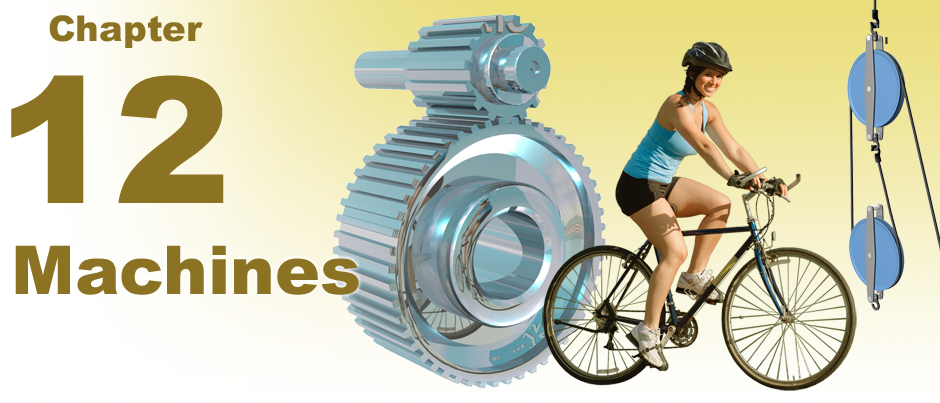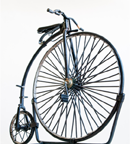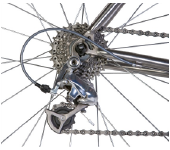 |
If you wanted to get around town 200 years ago you had to walk, ride a horse, or use a horse-drawn vehicle. Animals are not a very convenient transportation option; they require stabling, food, and veterinary care. The invention of the bicycle in the 19th century revolutionized personal transportation, allowing people to travel far more easily with an inexpensive, reliable vehicle. 
|
 In early bicycles the pedals were connected directly to the wheel. One turn of the pedals advanced the rider forward one circumference of the wheel. To move at a reasonable speed, this required a very large wheel. Although they provided good speed, large-wheel bicycles were difficult to get on or off and their high center of mass made them quite unsafe. Upon hitting a rut in the road an unlucky rider often rotated face-first into the ground!
In early bicycles the pedals were connected directly to the wheel. One turn of the pedals advanced the rider forward one circumference of the wheel. To move at a reasonable speed, this required a very large wheel. Although they provided good speed, large-wheel bicycles were difficult to get on or off and their high center of mass made them quite unsafe. Upon hitting a rut in the road an unlucky rider often rotated face-first into the ground! 
|
 By the late 19th century, bicycles began to use a drive train with a chain and sprockets. Pedals turn the front sprocket, which turns the smaller rear sprocket using a chain. By giving the front sprocket more teeth than the rear sprocket, each turn of the pedals could produce four or five turns of the rear wheel. Initially called the safety bicycle the new design quickly caught on. In 1949, Italian racer and inventor Tullio Campagnolo introduced the modern derailleur, which allows the rider to change the gear ratio between the front and rear sprockets while moving.
By the late 19th century, bicycles began to use a drive train with a chain and sprockets. Pedals turn the front sprocket, which turns the smaller rear sprocket using a chain. By giving the front sprocket more teeth than the rear sprocket, each turn of the pedals could produce four or five turns of the rear wheel. Initially called the safety bicycle the new design quickly caught on. In 1949, Italian racer and inventor Tullio Campagnolo introduced the modern derailleur, which allows the rider to change the gear ratio between the front and rear sprockets while moving. 
|
The development of the bicycle impacted society beyond allowing workers who could now live in a suburb to commute to work. This “freedom machine” empowered women, giving them mobility and the freedom that came with it. Suffragette Susan B. Anthony once remarked, “I think [the bicycle] has done more to emancipate women than anything else in the world.” 
|
 Today, bicycles come in a wide variety of models, from road bikes suitable for racing and mountain bikes for off-road riding to sturdy hybrids suitable for commuting in cities on potholed roads. Cycling enthusiasts compete in a host of different categories, including endurance events and single-speed bike races. Many of the early bicycle designs in the 19th century cost a worker the equivalent of several months’ salary. Bicycles today can be bought at virtually any quality and price, with children’s bikes costing less than a tank of gas.
Today, bicycles come in a wide variety of models, from road bikes suitable for racing and mountain bikes for off-road riding to sturdy hybrids suitable for commuting in cities on potholed roads. Cycling enthusiasts compete in a host of different categories, including endurance events and single-speed bike races. Many of the early bicycle designs in the 19th century cost a worker the equivalent of several months’ salary. Bicycles today can be bought at virtually any quality and price, with children’s bikes costing less than a tank of gas. 
|
| |
|

